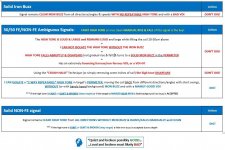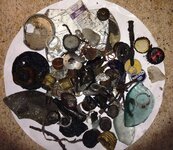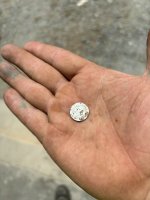Skiron
Jr. Member
- Aug 18, 2019
- 62
- 34
- Detector(s) used
- Equinox 800, XP Deus
- Primary Interest:
- All Treasure Hunting
Hello everyone! 
This is my very first post in the forum and I'm seeking your advice in my "newbie" questions regarding the use of my new Deus. I'm pretty inexperienced and new to metal detecting, so forgive me if my questions sound silly. However I have spend the last weeks reading all your informative posts (Vferarri, Calabash digger, Tnsharpshooter and other members too, a BIG thank you for your posts!) and watch a tone of videos (Gary's, Calabash's etc) regarding deus use and "language".
Some facts and info prior to my questions:
- I mainly hunt inland, such as farmer fields or pasture with significant WW2 or even older/ancient activity, as well as old 1700s houses/church yards with plenty of human activity back in time...so I consider myself as a rellic hunter with a "search for everything valuable or collectable" approach.
- All of my hunting spots seems to be highly minerallized. I'm a deus LITE user, so I don't have the remote with the mineralization strenght index-dots, and I'm using program10 goldfield to read and use the actual ground phase by pumping while pressing the "-" button to get a reading. The Ground Phase numbers I usualy grab with this method are at the 65-70 range (pretty low I suppose so I'm guesing tough soils in my areas, even if I dont have the mineralization bar-gram index to confirm it).
So I procceed and put manually the above GB reading in my custom programs...but most often I put a value of 70 and not lower because near 65 things starting to behave really weird.
I have to say here that I made a silver dime depth test barried @9'' in this minerallized hot ground, and at the factory preset GB of 88-90 I could not hear the dime. I picked the dime loud and clear only when setting GB close to my real ground phase, and start to hear the dime below GB 75 as my ground reads at 65-70. I'm choosing 70 most of the time and be careful not to hit the coil anywhere due to falsing.
-Many of my hunting spots are very thrashy with iron pieces (rusty also) and aluminum junk (think of 3-4 signals in every swing)
-My Deus "lite" is V5.1 updated and I'm using the 11'' X35 Coil, with the blue backphones wired to the small module, in order to have the module in hand for changing settings, watch VDI, ground balancing etc.
-My main "all-around" program is built upon "P6-Deep" (V2 filters...I know...little more chutty but I can handle, and I need this little bit of extra depth). Main reason I'm building my programs on P6-deep, is the fact that as a deus LITE user, i dont have access to silencer settings and deep program fulfills my need for reactivity @2 with silencer @-1. Furthermore, I like the 2-tone "dig no-dig" setup and especially 710hz tone as fits my ears pretty well, and have enough distance from 202hz to separate good targets from iron. I wouldn't use full tones since I need Iron Volume setting to set it lower in order to avoid iron down-averaging of good signals as well as to hear the good tones much better over the reduced iron volume when use some discrimination.
So, my custom program is:
Freq. 25Khz (due to high mineralized soil, medium conductivity targets preference, emi, & better separation amongst iron. It's also pretty deep and still hits a dime @9'' in the above soil conditions as tested real time)
Disc 7.5
Sensitivity: starting @95 and adjust +/- on site for stability, emi etc
TX power 2
Reactivity 2 (2.5 or 3 max in the very-very trashy areas...but 90% of the time I use reactivity @2)
Silencer -1
2 tones: 202hz / 710hz
Iron Volume 2-3 max
Ground Balance: manual, usually @70 (grabing the reading with goldfield as mentioned above) *I don't really trust Tracking GB since I have a lot of iron junk in my sites
Audio response 3 (really need to distinguish deep from shallow if i want to cerry pick only good deep targets amongst junk)
So here comes the newbie questions, all regarding Signal-target recognition before diging:
I have seperate the signals in 3 main categories in my head, and take the apropriate action for each category by it's characteristics. Let me explain:
1st Category: Solid Iron Buzz
- Signal remains iron buzz in any direction & swing speed, with only ferrous VDI numbers => Don’t dig!
- Signal introduces a good tone in at least one direction or when applying a different swing speed => NEED ADVICE!
- Signal is very faint & low volume (deep target indication) and by removing some soil it turns to a good tone => DIIIIIIIIIIIIIIG!
- Signal gives a VDI of 6, indicating a possible masked good target and when pinpointing with very slow speed introduces a good tone =>DIG!
2nd Category: 50/50 Signals: Good tone amongst iron tones (great tone followed by clipping and buzzing)
- The good part of the signal is loud and is almost 50% iron tone-50% good tone, both loud =>NEED ADVICE!!
- The good part of the signal is FAINT (low volume), with or without iron buzz (deep target indication) => DIIIIIIIIIIIIIIG!
3rd Category: Solid Non-Ferrous Tone
- Signal is loud and/or broken & stays loud with coil lifting, has a forced “digital” not smooth tone, has a high VDI (>90), raises/falls abruptly or brakes up as I swing back the coil, turns to iron buzz in the edges => Don't dig!
- Signal is loud but smooth, with a VDI <97-99, without iron buzz in the edge, rises/falls gradually & faints while lifting the coil => DIG!
- Signal is FAINT (low volume), with or without iron buzz (deep target indication) => DIIIIIIIIIIIIIIG!
I hope that I explained the best way I could what's in my head, but this is the strategy I'm following regarding signals recognition and further actions.
My main insecurity is especially in 2nd signals category of 50/50 loud signals , as well as Iron falsing and wraparound recognition in 3rd signals category....so I would extremelly apreciate your thoughts and inputs in my strategy above.......
Ofcourse, the best advice for everything is PRACTICE-PRACTICE-PRACTICE and FIELD HOURS to learn what you hear, but I'd like to know if I'm in the right direction...
Thanks a million and regards from Greece!

This is my very first post in the forum and I'm seeking your advice in my "newbie" questions regarding the use of my new Deus. I'm pretty inexperienced and new to metal detecting, so forgive me if my questions sound silly. However I have spend the last weeks reading all your informative posts (Vferarri, Calabash digger, Tnsharpshooter and other members too, a BIG thank you for your posts!) and watch a tone of videos (Gary's, Calabash's etc) regarding deus use and "language".
Some facts and info prior to my questions:
- I mainly hunt inland, such as farmer fields or pasture with significant WW2 or even older/ancient activity, as well as old 1700s houses/church yards with plenty of human activity back in time...so I consider myself as a rellic hunter with a "search for everything valuable or collectable" approach.
- All of my hunting spots seems to be highly minerallized. I'm a deus LITE user, so I don't have the remote with the mineralization strenght index-dots, and I'm using program10 goldfield to read and use the actual ground phase by pumping while pressing the "-" button to get a reading. The Ground Phase numbers I usualy grab with this method are at the 65-70 range (pretty low I suppose so I'm guesing tough soils in my areas, even if I dont have the mineralization bar-gram index to confirm it).
So I procceed and put manually the above GB reading in my custom programs...but most often I put a value of 70 and not lower because near 65 things starting to behave really weird.
I have to say here that I made a silver dime depth test barried @9'' in this minerallized hot ground, and at the factory preset GB of 88-90 I could not hear the dime. I picked the dime loud and clear only when setting GB close to my real ground phase, and start to hear the dime below GB 75 as my ground reads at 65-70. I'm choosing 70 most of the time and be careful not to hit the coil anywhere due to falsing.
-Many of my hunting spots are very thrashy with iron pieces (rusty also) and aluminum junk (think of 3-4 signals in every swing)
-My Deus "lite" is V5.1 updated and I'm using the 11'' X35 Coil, with the blue backphones wired to the small module, in order to have the module in hand for changing settings, watch VDI, ground balancing etc.
-My main "all-around" program is built upon "P6-Deep" (V2 filters...I know...little more chutty but I can handle, and I need this little bit of extra depth). Main reason I'm building my programs on P6-deep, is the fact that as a deus LITE user, i dont have access to silencer settings and deep program fulfills my need for reactivity @2 with silencer @-1. Furthermore, I like the 2-tone "dig no-dig" setup and especially 710hz tone as fits my ears pretty well, and have enough distance from 202hz to separate good targets from iron. I wouldn't use full tones since I need Iron Volume setting to set it lower in order to avoid iron down-averaging of good signals as well as to hear the good tones much better over the reduced iron volume when use some discrimination.
So, my custom program is:
Freq. 25Khz (due to high mineralized soil, medium conductivity targets preference, emi, & better separation amongst iron. It's also pretty deep and still hits a dime @9'' in the above soil conditions as tested real time)
Disc 7.5
Sensitivity: starting @95 and adjust +/- on site for stability, emi etc
TX power 2
Reactivity 2 (2.5 or 3 max in the very-very trashy areas...but 90% of the time I use reactivity @2)
Silencer -1
2 tones: 202hz / 710hz
Iron Volume 2-3 max
Ground Balance: manual, usually @70 (grabing the reading with goldfield as mentioned above) *I don't really trust Tracking GB since I have a lot of iron junk in my sites
Audio response 3 (really need to distinguish deep from shallow if i want to cerry pick only good deep targets amongst junk)
So here comes the newbie questions, all regarding Signal-target recognition before diging:
I have seperate the signals in 3 main categories in my head, and take the apropriate action for each category by it's characteristics. Let me explain:
1st Category: Solid Iron Buzz
- Signal remains iron buzz in any direction & swing speed, with only ferrous VDI numbers => Don’t dig!
- Signal introduces a good tone in at least one direction or when applying a different swing speed => NEED ADVICE!
- Signal is very faint & low volume (deep target indication) and by removing some soil it turns to a good tone => DIIIIIIIIIIIIIIG!
- Signal gives a VDI of 6, indicating a possible masked good target and when pinpointing with very slow speed introduces a good tone =>DIG!
2nd Category: 50/50 Signals: Good tone amongst iron tones (great tone followed by clipping and buzzing)
- The good part of the signal is loud and is almost 50% iron tone-50% good tone, both loud =>NEED ADVICE!!
- The good part of the signal is FAINT (low volume), with or without iron buzz (deep target indication) => DIIIIIIIIIIIIIIG!
3rd Category: Solid Non-Ferrous Tone
- Signal is loud and/or broken & stays loud with coil lifting, has a forced “digital” not smooth tone, has a high VDI (>90), raises/falls abruptly or brakes up as I swing back the coil, turns to iron buzz in the edges => Don't dig!
- Signal is loud but smooth, with a VDI <97-99, without iron buzz in the edge, rises/falls gradually & faints while lifting the coil => DIG!
- Signal is FAINT (low volume), with or without iron buzz (deep target indication) => DIIIIIIIIIIIIIIG!
I hope that I explained the best way I could what's in my head, but this is the strategy I'm following regarding signals recognition and further actions.
My main insecurity is especially in 2nd signals category of 50/50 loud signals , as well as Iron falsing and wraparound recognition in 3rd signals category....so I would extremelly apreciate your thoughts and inputs in my strategy above.......
Ofcourse, the best advice for everything is PRACTICE-PRACTICE-PRACTICE and FIELD HOURS to learn what you hear, but I'd like to know if I'm in the right direction...
Thanks a million and regards from Greece!

Amazon Forum Fav 👍
Last edited:




 Whats your advice on this? (remember, I'm a lite user so I read ground phase by using P10 goldfield and ground menu in ws4 while pressing the "-" button...then I manualy set the reading obtained in my custom program)
Whats your advice on this? (remember, I'm a lite user so I read ground phase by using P10 goldfield and ground menu in ws4 while pressing the "-" button...then I manualy set the reading obtained in my custom program)


